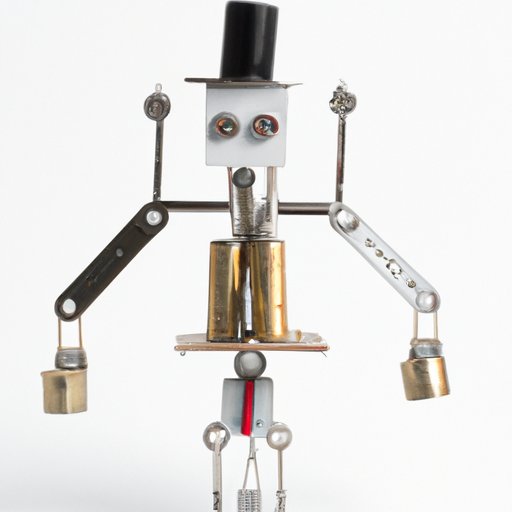Introduction
Robots have been around for centuries, but the first true robot was invented in the 1950s. So, when was the first robot invented? This article will explore the history of robotics and look at the development of the first robot, from its earliest prototypes to its modern-day counterparts. We’ll examine the science behind the creation of the first robot, the pioneers who invented it, and the impact it had on society.
A Historical Look at the Invention of the First Robot
The concept of robots has been around since ancient times. The ancient Greeks used automata to entertain their guests, while the Chinese developed mechanical devices to perform a variety of tasks. However, these early robotic devices lacked the sophistication of modern robots.
In the 1950s, two American inventors, Joseph Engelberger and George Devol, developed the first programmable robot, which they called Unimate. This robot was able to move and manipulate objects with precision, making it the first true robot.
Engelberger and Devol’s invention of Unimate marked a turning point in the history of robotics. From this point forward, robotics technology advanced rapidly, leading to the development of more sophisticated robots capable of performing complex tasks.

Exploring the Science Behind the Creation of the First Robot
The development of Unimate required an understanding of both physics and mechanics. Engelberger and Devol had to consider the forces acting on the robot’s body as well as its range of motion. They also had to take into account the weight of the components and the power required to move them.
In addition to physics, electronics played an important role in the design of Unimate. Engelberger and Devol had to develop circuits and logic gates that could control the robot’s movements. They also had to create programming instructions that would enable the robot to complete its tasks.

The Pioneers Who Invented the First Robot
Joseph Engelberger is often credited with being the father of robotics. He was a pioneer in the field and helped to shape the direction of the industry. In the 1950s, he formed a company called Unimation, which focused on creating industrial robots.
George Devol was another key figure in the development of Unimate. He was a prolific inventor who held more than 100 patents related to robotics. He worked closely with Engelberger to develop the first robot, and his contributions were essential to its success.
Together, Engelberger and Devol created Unimate, a robot that revolutionized the manufacturing industry. It was the first robot capable of performing repetitive tasks with great accuracy and speed.
How the First Robot Set a Precedent for Modern Robotics
The invention of Unimate set a precedent for modern robotics. Subsequent models of robots were able to perform more complex tasks, such as assembly line work or product inspection. These robots also incorporated advances in artificial intelligence, allowing them to make decisions based on data.
The development of Unimate also paved the way for the use of robots in other industries, such as healthcare, education, and entertainment. Today, robots are used in a variety of settings, from hospitals to factories to homes.

Examining the Impact of the First Robot on Society
The invention of Unimate had a significant impact on society. Automation allowed companies to increase production and reduce costs, leading to greater profits. Additionally, robots enabled people to do more with less effort, freeing up time for leisure activities.
However, there are potential downsides to automation. For example, robots can lead to job losses as they replace human workers in certain industries. This can have a negative effect on the economy, as people may struggle to find new employment.

The Technology Behind the Design of the First Robot
The design of Unimate involved several components. The robot was composed of an arm, a base, and a controller. The arm was responsible for manipulating objects, while the base provided stability and mobility. The controller was responsible for processing commands and carrying out instructions.
In addition to the physical components, Unimate also required programming. This involved writing code that would enable the robot to carry out specific tasks. Engelberger and Devol had to create algorithms that would allow the robot to accurately complete its assigned tasks.
An Analysis of the Social Implications of the First Robot
The invention of Unimate had far-reaching implications for society. On the one hand, automation can lead to job losses as robots replace human workers. On the other hand, it can also improve quality of life by freeing up people’s time and reducing the amount of manual labor required.
Furthermore, robots can help to reduce costs and increase efficiency, leading to better products and services. They can also be used to perform dangerous tasks, such as exploring hazardous environments or diffusing bombs.
Conclusion
The invention of the first robot, Unimate, marked a turning point in the history of robotics. It set a precedent for subsequent models and paved the way for the use of robots in a variety of settings. The development of Unimate also had a significant impact on society, with both positive and negative implications.
The invention of Unimate demonstrated the potential of robotics technology and opened up a world of possibilities. Today, robots are used in many different industries and are helping to improve our quality of life. The first robot may have been invented over 60 years ago, but its legacy still lives on.
(Note: Is this article not meeting your expectations? Do you have knowledge or insights to share? Unlock new opportunities and expand your reach by joining our authors team. Click Registration to join us and share your expertise with our readers.)
